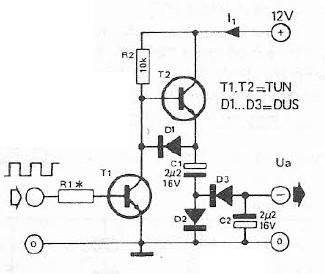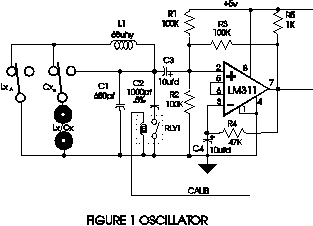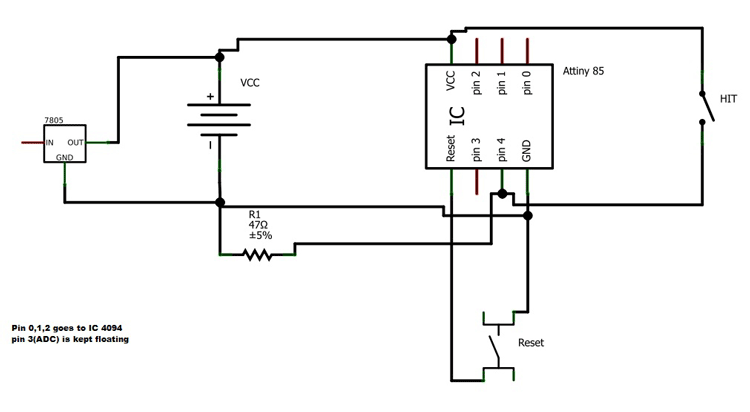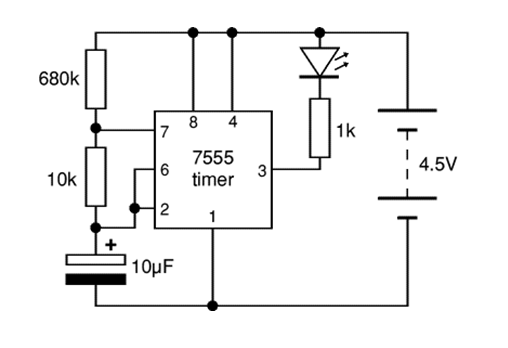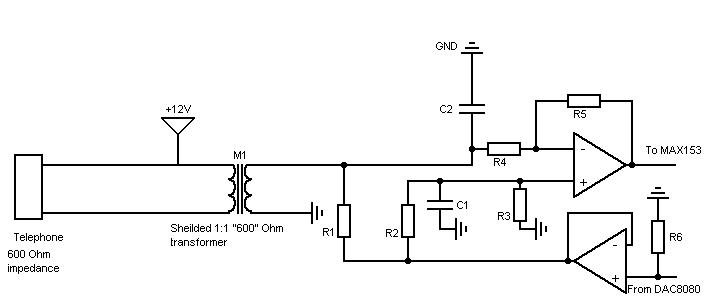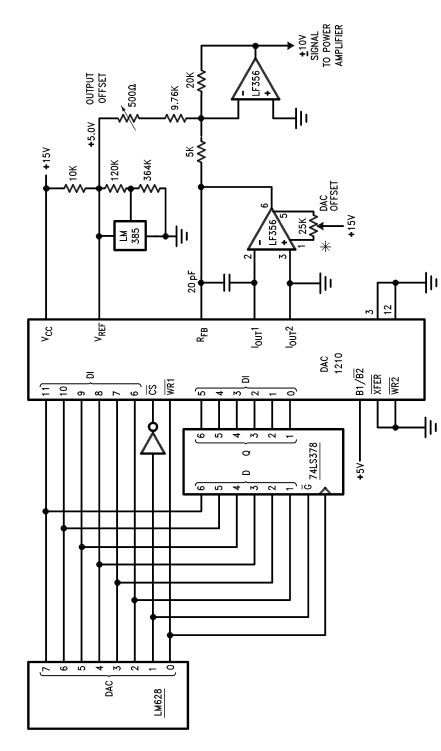
project armageddon processor
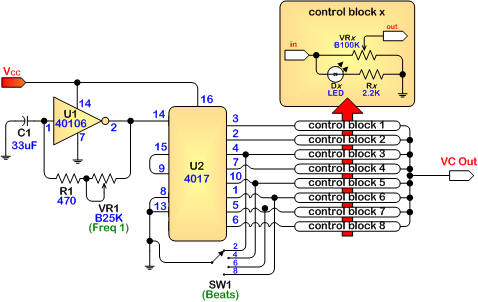
This circuit is a simple JFET input buffer that connects to a clean boost inspired by the Electro-Harmonix LPB-1 Linear Power Boost. The guitar input is buffered and then split into four input points, allowing connections to various other modules. A standard Fuzz Face is included, modified to use NPN MPSA18 transistors, with the fixed bias resistor replaced by a potentiometer. The design incorporates the Fuzz Face's distinct sound. The Black Fuzz is a combination of single and double transistor designs, featuring two transistors arranged back to back with an added filter. The PWM fuzz circuit, based on a Schmitt trigger, has been modified to cascade an additional gate with a filter control. The LM567 chip, originally designed for decoding touch-tone frequencies, has been adapted into a modifier that can produce sounds ranging from choppy tremolo to a harsh ring modulator. A novel approach to utilizing a 555 timer as an oscillator has been developed, resulting in a tunable oscillator. This design also features two drone oscillators created using a 40106 Schmitt Trigger chip. Additionally, an 8-step sequencer is employed to drive a voltage-controlled filter, with the 40106 serving as a low-frequency oscillator (LFO) to pulse a 4017 decade counter. The voltage-controlled filter design is still in progress. Consideration is being given to incorporating an analog delay, with a potential alternative being the MODBoard Analog delay for feasibility.
This circuit design showcases a comprehensive approach to building a modular audio processing unit, integrating various classic effects and innovative modifications. The JFET input buffer serves as the initial stage, providing impedance matching and signal integrity for the guitar input. The clean boost section amplifies the signal without introducing unwanted distortion, maintaining the tonal characteristics of the instrument.
The Fuzz Face module, utilizing NPN MPSA18 transistors, retains the signature fuzz sound while allowing for user adjustments through the potentiometer bias control. This flexibility enables the user to dial in the desired level of distortion, enhancing the overall tonal palette available.
The Black Fuzz section, with its dual-transistor configuration and filter, adds further sonic versatility, allowing for a range of fuzz tones. The PWM fuzz circuit introduces a dynamic element, with the Schmitt trigger design providing a unique character to the fuzz effect. The additional gate and filter control enable nuanced sound shaping, catering to diverse musical styles.
The integration of the LM567 chip expands the capabilities of the circuit, allowing for the exploration of frequency modulation effects. The 555 timer oscillator, while traditionally simple, has been reimagined to produce complex tones suitable for experimental sound design.
The dual drone oscillators, driven by the 40106 Schmitt Trigger, create rich, textured soundscapes, while the 8-step sequencer adds rhythmic complexity to the output. This sequencer, combined with the voltage-controlled filter, offers extensive sound manipulation possibilities, encouraging creative experimentation.
The ongoing development of the voltage-controlled filter indicates a commitment to refining the circuit's functionality, ensuring that it meets the evolving needs of the user. The consideration of an analog delay, alongside the exploration of the MODBoard Analog delay, reflects a pragmatic approach to achieving high-quality sound processing without overextending the project's scope.
Overall, this circuit exemplifies a thoughtful integration of established electronic components with innovative modifications, resulting in a versatile and powerful audio processing unit suitable for a variety of musical applications.This is a simple JFET input buffer that goes into a clean boost based on the old Electro-Harmonix LPB-1 Linear Power Boost. The guitar input is buffered and then split off to four input points. These input points can then go on to various other modules in the box. A bog-standard Fuzz Face. The only mod is that I`m using NPN MPSA18 transistors and the traditional fixed bias resistor has been turned into a pot. I love the snarly nastiness of the Fuzz Face so it would have been crazy not to included it in a box centered around fuzz. If I had to dedicate the work behind the Armageddon Processor to any single person, it would probably be Christian/Hemmo.
He has one of the most offbeat DIY sites. It hasn`t been updated in a long time, and it is ugly as hell as sites go, but his little snippets have gone a long way. The Black Fuzz is based on his single and double transistor designs. I put two of them back to back and added a filter. Tim Escobedo `s Circuit Snippets is one of the crown jewels of the DIY schematics world. He has so many designs that are different and thought-provoking. One of those is the PWM, a fuzz that is based on a Schmitt trigger. I modified this design to cascade an additional gate and added a filter control. Lovely. Another nod to hemmo/christian here. He had a couple of circuits based on the LM567 chip. This bizarred device was designed to decode touch-tone frequencies on telephones. His hackage opened my eyes to this msytical device and I spent many hours at the breadboard trying all the possible permutations of what the 567 can do.
I ended up with a modifier that can go from a choppy tremolo to a nasty ring mod at the twist of a dial. Like an idiot alchemist trying to turn lead into gold, I`ve spent a lot of time trying to get faux synthesizer tones out of a 555 timer.
I`ve pored over John Hollis Crash Sync and Tim Escobedo`s Uglyface. I have a binder full of nothing but 555 datasheets, schematics, ideas and what-nots. The end result is a slightly novel approach to using the 555 as an oscillator. Many months ago I added a simple mixer and an opamp function generator to a big muff pi. The result was a tunable oscillator that I could riff along with. What could be better than a drone oscillator Why, two drone oscillators of course. This simple design uses a 40106 Schmitt Trigger chip to create two tunable tone sources. This is probably the most exciting of the modules. It is an 8-step sequencer driving a voltage controlled filter. Again the 40106 is pressed into service as a LFO to pulse a 4017 decade counter. I found the idea for this from Bill Bowden`s very bitchin` site in the form of a LED sequencer. I dispensed with the 555 timer LFO because it was noisy as hell and clicked and clacked. The VCF design is not finalized yet, so many choices to try there. It sure would be nice to add an analog delay to this box. Here`s the thing though: I`ll build an analog delay when monkeys fly out of my ass. Not that it wouldn`t be cool to build an analog delay, but at some point this project actually has to end. So as a compromise, I`m toying around with the MODBoard Analog delay. Sounds pretty good so far, and at only 50 bucks for the populated/built/tested board, it just may be a feasible alternative.
🔗 External reference
This circuit design showcases a comprehensive approach to building a modular audio processing unit, integrating various classic effects and innovative modifications. The JFET input buffer serves as the initial stage, providing impedance matching and signal integrity for the guitar input. The clean boost section amplifies the signal without introducing unwanted distortion, maintaining the tonal characteristics of the instrument.
The Fuzz Face module, utilizing NPN MPSA18 transistors, retains the signature fuzz sound while allowing for user adjustments through the potentiometer bias control. This flexibility enables the user to dial in the desired level of distortion, enhancing the overall tonal palette available.
The Black Fuzz section, with its dual-transistor configuration and filter, adds further sonic versatility, allowing for a range of fuzz tones. The PWM fuzz circuit introduces a dynamic element, with the Schmitt trigger design providing a unique character to the fuzz effect. The additional gate and filter control enable nuanced sound shaping, catering to diverse musical styles.
The integration of the LM567 chip expands the capabilities of the circuit, allowing for the exploration of frequency modulation effects. The 555 timer oscillator, while traditionally simple, has been reimagined to produce complex tones suitable for experimental sound design.
The dual drone oscillators, driven by the 40106 Schmitt Trigger, create rich, textured soundscapes, while the 8-step sequencer adds rhythmic complexity to the output. This sequencer, combined with the voltage-controlled filter, offers extensive sound manipulation possibilities, encouraging creative experimentation.
The ongoing development of the voltage-controlled filter indicates a commitment to refining the circuit's functionality, ensuring that it meets the evolving needs of the user. The consideration of an analog delay, alongside the exploration of the MODBoard Analog delay, reflects a pragmatic approach to achieving high-quality sound processing without overextending the project's scope.
Overall, this circuit exemplifies a thoughtful integration of established electronic components with innovative modifications, resulting in a versatile and powerful audio processing unit suitable for a variety of musical applications.This is a simple JFET input buffer that goes into a clean boost based on the old Electro-Harmonix LPB-1 Linear Power Boost. The guitar input is buffered and then split off to four input points. These input points can then go on to various other modules in the box. A bog-standard Fuzz Face. The only mod is that I`m using NPN MPSA18 transistors and the traditional fixed bias resistor has been turned into a pot. I love the snarly nastiness of the Fuzz Face so it would have been crazy not to included it in a box centered around fuzz. If I had to dedicate the work behind the Armageddon Processor to any single person, it would probably be Christian/Hemmo.
He has one of the most offbeat DIY sites. It hasn`t been updated in a long time, and it is ugly as hell as sites go, but his little snippets have gone a long way. The Black Fuzz is based on his single and double transistor designs. I put two of them back to back and added a filter. Tim Escobedo `s Circuit Snippets is one of the crown jewels of the DIY schematics world. He has so many designs that are different and thought-provoking. One of those is the PWM, a fuzz that is based on a Schmitt trigger. I modified this design to cascade an additional gate and added a filter control. Lovely. Another nod to hemmo/christian here. He had a couple of circuits based on the LM567 chip. This bizarred device was designed to decode touch-tone frequencies on telephones. His hackage opened my eyes to this msytical device and I spent many hours at the breadboard trying all the possible permutations of what the 567 can do.
I ended up with a modifier that can go from a choppy tremolo to a nasty ring mod at the twist of a dial. Like an idiot alchemist trying to turn lead into gold, I`ve spent a lot of time trying to get faux synthesizer tones out of a 555 timer.
I`ve pored over John Hollis Crash Sync and Tim Escobedo`s Uglyface. I have a binder full of nothing but 555 datasheets, schematics, ideas and what-nots. The end result is a slightly novel approach to using the 555 as an oscillator. Many months ago I added a simple mixer and an opamp function generator to a big muff pi. The result was a tunable oscillator that I could riff along with. What could be better than a drone oscillator Why, two drone oscillators of course. This simple design uses a 40106 Schmitt Trigger chip to create two tunable tone sources. This is probably the most exciting of the modules. It is an 8-step sequencer driving a voltage controlled filter. Again the 40106 is pressed into service as a LFO to pulse a 4017 decade counter. I found the idea for this from Bill Bowden`s very bitchin` site in the form of a LED sequencer. I dispensed with the 555 timer LFO because it was noisy as hell and clicked and clacked. The VCF design is not finalized yet, so many choices to try there. It sure would be nice to add an analog delay to this box. Here`s the thing though: I`ll build an analog delay when monkeys fly out of my ass. Not that it wouldn`t be cool to build an analog delay, but at some point this project actually has to end. So as a compromise, I`m toying around with the MODBoard Analog delay. Sounds pretty good so far, and at only 50 bucks for the populated/built/tested board, it just may be a feasible alternative.
🔗 External reference
